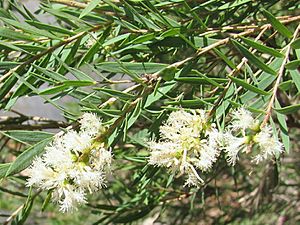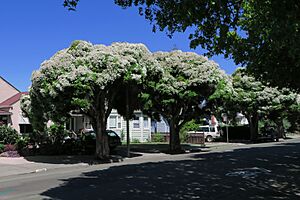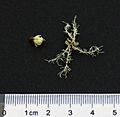Flax-leaved paperbark facts for kids
Quick facts for kids Snow-in-summer |
|
|---|---|
 |
|
| Melaleuca linariifolia leaves and flowers | |
| Scientific classification | |
| Genus: |
Melaleuca
|
| Species: |
linariifolia
|
Melaleuca linariifolia is a plant from the Myrtaceae family, which includes myrtle trees. It grows naturally only in eastern Australia. People often call it snow-in-summer because of its many white flowers. Other names are narrow-leaved paperbark and flax-leaved paperbark. The Cadigal people, an Aboriginal group, call it budjur.
This plant is very tough and grows lots of flowers in late spring or summer. This makes it a popular choice for gardens and parks in places with mild weather. Another similar plant is Melaleuca trichostachya, but its leaves are arranged differently, and its fruits look a bit different.

Contents
What Snow-in-Summer Looks Like
Melaleuca linariifolia is a small tree. It usually grows to be about 6 to 10 metres (20 to 33 feet) tall. It has special white or creamy-white bark that feels like paper. The tree also has a thick top part, which is called a canopy.
Its leaves are arranged in pairs, one opposite the other, all the way up the stem. They are smooth and can be 17 to 45 millimetres (0.7 to 1.8 inches) long and 1 to 4 millimetres (0.04 to 0.16 inches) wide. The leaves are thin and shaped like a spear, with a clear line down the middle.
Flowers and Fruits
The flowers are white to creamy-white and smell nice. They grow in spikes at the ends of branches. These branches keep growing even after the flowers appear. Each flower spike can be up to 40 millimetres (1.6 inches) wide and long. There are usually 4 to 20 individual flowers in each spike.
The petals of the flowers are small, about 2.5 to 3.3 millimetres (0.10 to 0.13 inches) long. They fall off as the flower gets older. Inside the flower, there are many stamens (the parts that make pollen). These stamens are grouped into five bundles, with 32 to 73 stamens in each bundle.
The tree is covered in flowers for a short time, usually from October to February. After the flowers, small, woody fruits appear. These fruits are like capsules, about 2.5 to 4 millimetres (0.10 to 0.16 inches) long and 4 to 5 millimetres (0.16 to 0.20 inches) wide. They are scattered along the stems. The parts of the fruit that open to release seeds do not stick out past the edge of the capsule.
How Snow-in-Summer Got Its Name
The plant Melaleuca linariifolia was first officially described in 1797 by a scientist named James Edward Smith. He wrote about it in a science journal. Smith mentioned that a person named Mr. White said it was a large tree with very thick, spongy bark. This bark could even be used like tinder to start fires!
The second part of the plant's name, linariifolia, means "with leaves like Linaria." Linaria is another type of plant. This tells us that the leaves of the snow-in-summer tree look similar to the leaves of Linaria plants.
Where Snow-in-Summer Grows
Snow-in-summer grows naturally in eastern Australia. You can find it from the Maryborough area in Queensland down to the Ulladulla area in New South Wales. There's also a separate group of these trees in the Blackdown Tableland National Park in Queensland.
This tree likes to grow in areas with heath (a type of shrubland) and dry sclerophyll forest. It is often found near rivers, creeks, or swampy areas.
How People Use Snow-in-Summer
Growing Snow-in-Summer in Gardens
Melaleuca linariifolia is a popular tree for gardens and parks. People also plant it to create screens or windbreaks, both in Australia and other countries. It's a common tree planted along streets in Melbourne, Victoria.
This tree can handle different conditions. It grows well in both dry and very wet (boggy) places. It can also survive frost. However, it's important to plant it carefully. Its roots can be strong, so it's best not to plant it too close to pipes. Also, because it can catch fire easily, it should not be planted very close to buildings in areas where bushfires are common.
Snow-in-summer is good for native animals because it provides food and a home for many insects. There are also smaller versions of this tree that have been grown for gardens. For example, 'Snowstorm' grows to about 1.5 metres (5 feet) tall, 'Seafoam' grows to 2.5 metres (8 feet), and 'Claret Tops' grows to 1.5 metres (5 feet) and has new leaves that are a reddish-purple color.
Using Snow-in-Summer for Oils
This tree is full of special oils called essential oils. One important oil found in it is called Terpinen-4-ol. This tree can grow in more types of environments than Melaleuca alternifolia, which is the main plant used to make "tea tree" oil right now. Because of this, Melaleuca linariifolia might become another important source for tea tree oil in the future.
Gallery
See also
 In Spanish: Nieve en verano para niños
In Spanish: Nieve en verano para niños










